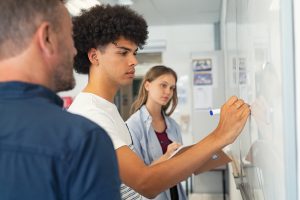The Benefits of Kinesthetic Learning for Students
Kinesthetic learning is a style of learning that involves physical movement, allowing learners to engage with the material through hands-on experiences. This approach to learning can be particularly effective for students who struggle with traditional teaching methods or who benefit from a more active, dynamic approach to education.
Research has shown that it can provide a range of benefits for students. For example, it can help improve memory retention by engaging multiple areas of the brain, making it easier to recall information later on.
Additionally, it can increase engagement and motivation, as learners are more likely to stay interested and focused when they are actively involved in the learning process.
Another benefit of using this type of learning technique is that it can help students develop critical thinking skills. When students are given opportunities to experiment and explore with hands-on activities, they are more likely to develop problem-solving skills and make connections between different concepts.
Finally, it can help improve behavior and social skills by allowing learners to work collaboratively and build relationships with their peers. By engaging in physical activities together, students are more likely to develop communication and teamwork skills that can benefit them both in and out of the classroom.
How can kinesthetic learning improve the learning process?
So, how does it actually work? How can kinesthetic learning improve the learning process? The science behind it reveals how physical movement can improve learning outcomes. When learners engage in physical activities, it stimulates the brain in ways that traditional teaching methods cannot.
Research studies support the notion that it is beneficial for students. Studies have shown that when students are given opportunities to engage in movement-based learning activities, they are more likely to retain information and demonstrate improved performance on academic assessments.
This is likely because movement-based learning activities engage multiple areas of the brain simultaneously, leading to a more holistic understanding of the material.
One reason why it is effective is because movements can help improve memory retention. When students engage in physical activities, they are more likely to create stronger neural connections between different pieces of information, making it easier for them to remember what they have learned later on.
This is supported by research that has found that students who participate in movement-based learning activities demonstrate improved memory recall compared to those who learn using traditional teaching methods.
The brain processes movement-based learning differently than other types of learning. When learners engage in physical activities, the brain releases neurotransmitters such as dopamine and serotonin, which can improve mood and motivation. This can lead to increased engagement and better overall learning outcomes.
Additionally, physical movement can help activate the cerebellum, which is involved in coordinating movement and balance, as well as the prefrontal cortex, which is involved in higher-level thinking and decision-making.
What are the benefits of kinesthetic learning?
What are the benefits of kinesthetic learning? It can provide a wide range of benefits for students of all ages and abilities. In this section, we will explore some of the specific benefits that students can experience through it.
One of its key benefits is improved memory retention. When students engage in physical activities while learning, it creates stronger neural connections in the brain, making it easier to recall information later on. This can be especially helpful for students who struggle with memorization or who have difficulty focusing for extended periods of time.
Another one of its benefits is increased engagement and motivation. When students are actively involved in the learning process, they are more likely to stay interested and invested in the material. This can lead to increased motivation to learn and improved overall academic performance.
In addition to improved memory retention and increased engagement, it can help students develop critical thinking skills. By engaging in hands-on activities and experiments, students are more likely to make connections between different concepts and develop problem-solving skills. This can help prepare them for future academic and professional pursuits.
Finally, kinesthetic learning can also improve behavior and social skills. When students engage in physical activities together, they are more likely to build relationships with their peers and to develop communication and teamwork skills. This can lead to improved social and emotional well-being and help students develop important life skills that can benefit them both in and out of the classroom.
How can I incorporate kinesthetic learning strategies in understanding lessons?
How can I incorporate kinesthetic learning strategies in understanding lessons? There are several methods that teachers can use to help students engage with the material through physical movement.
One approach is to incorporate movement into understanding lessons. For example, teachers can encourage students to act out the steps of a process, such as a science experiment, or use hand gestures to help them remember key vocabulary terms. This can be particularly effective for students who are visual or tactile learners.
Another strategy is to use manipulatives and tactile learning materials, such as blocks or puzzles, to help students better understand abstract concepts. This approach can be particularly effective in subjects like math and science, where students may struggle to visualize complex concepts.
Incorporating physical activities into group work can also be an effective way to engage students in kinesthetic learning. For example, teachers can have students work together to create a model or a presentation that requires physical movement, such as a skit or a dance. This approach can help students build teamwork and communication skills while also staying actively engaged in the learning process.
Finally, taking regular brain breaks and incorporating movement-based activities between lessons can also help students stay engaged and focused. For example, teachers can lead a brief stretching exercise or a quick game of Simon Says to help students re-energize and refocus before moving on to the next lesson.
Kinesthetic learning strategies can be effective across a wide range of subjects and grade levels. Here are some examples of successful kinesthetic learning in action:
In science classes, teachers can use hands-on experiments to help students learn about topics such as the properties of matter or the mechanics of motion. For example, students can build simple machines or create chemical reactions to help reinforce key concepts.
In math classes, teachers can use manipulatives such as blocks, number lines, or fraction strips to help students visualize abstract concepts. This can be particularly helpful for students who struggle with traditional math teaching methods.
In language classes, teachers can incorporate physical activities such as role-playing or charades to help students practice new vocabulary or grammar concepts. This can be a fun and engaging way to practice language skills while incorporating physical movement.
In physical education classes, teachers can use team sports and physical challenges to help students develop teamwork and problem-solving skills. For example, students can work together to complete a challenging obstacle course or engage in a friendly game of capture the flag.
In all subjects, teachers can incorporate movement breaks and activities to help students stay engaged and focused. For example, teachers can lead a quick dance or yoga break to help students re-energize and refocus before moving on to the next lesson.
What are the challenges in kinesthetic learning?
What are the challenges in kinesthetic learning? While it can be a highly effective teaching approach, there are also some challenges and considerations that teachers must keep in mind when incorporating movement-based activities into their lessons. Here are a few key factors to consider:
Addressing concerns about noise and disruption: One potential challenge is that it can be noisy and disruptive, particularly if students are moving around the classroom or working in groups. Teachers may need to establish clear expectations and guidelines for movement-based activities to ensure that students are staying on-task and not disrupting other students’ learning.
Accommodating different learning styles and abilities: While it can be highly effective for some students, it may not be the best approach for everyone. Teachers should be prepared to accommodate a range of learning styles and abilities by incorporating a variety of teaching methods, including visual, auditory, and tactile approaches.
Integrating kinesthetic learning with other teaching methods: It should not be used exclusively as a teaching approach, but rather integrated with other teaching methods to create a well-rounded learning experience. Teachers may need to be creative in finding ways to incorporate movement-based activities into lessons without sacrificing other important teaching elements such as lectures, discussions, or independent work.
Providing appropriate resources and materials: Teachers may need to invest in appropriate resources and materials to support their activities, such as manipulatives, props, or physical activity equipment. It’s important to ensure that these resources are safe and appropriate for the age and ability level of the students.
Kinesthetic learning can provide a wide range of benefits for students of all ages and abilities. By incorporating physical movement into learning activities, teachers can help students improve memory retention, increase engagement and motivation, develop critical thinking skills, and improve behavior and social skills. It can be effective across a wide range of subjects and grade levels, and there are many innovative strategies being used in classrooms today.
While there are some challenges and considerations to keep in mind when incorporating kinesthetic learning into the classroom, these can be addressed through clear guidelines, accommodation of different learning styles and abilities, integration with other teaching methods, and appropriate resources and materials.
Given the many benefits and its potential, educators should consider incorporating more movement-based education into their teaching. By using a variety of teaching methods, including kinesthetic learning, teachers can help meet the diverse needs of their students and create a dynamic and engaging learning environment.
With a little creativity and planning, teachers can effectively integrate movement-based activities into their lessons and help students achieve their academic goals.
You can gain further insights into college admissions by seeking the guidance of college admissions experts, such as those available at AdmissionSight. With over a decade of experience helping students navigate the competitive admissions process and secure acceptance to some of the world’s best universities, AdmissionSight is an excellent resource. You are welcome to schedule an appointment for your first consultation at any time.







































